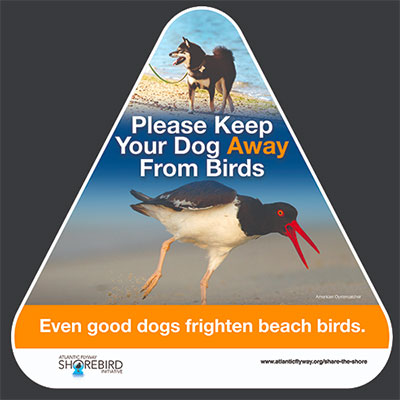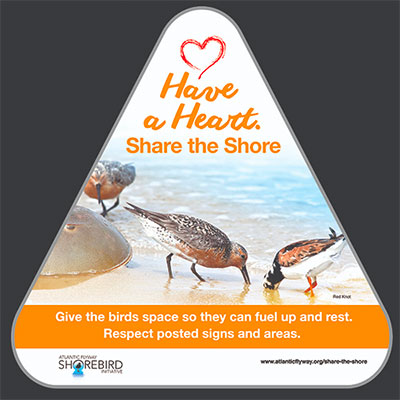Welcome to the searchable Shorebird Outreach Resource Directory. The materials here are available for downloading, sharing, and most may be modified for your own use. If you have material you would like to share with the broader shorebird community please submit your material for approval.
Field Guide: Common Beach Birds of the Georgia Bight
This was designed by Manomet Staff with the support of a Georgia Department of Natural Resources Wildlife Viewing Grant. This was printed on two-sided waterproof paper.
We give these out at events, on beaches when stewarding, and to partner organizations.
If you use these materials, please contact us so we can track our reach numbers and locations!
ahayser@manomet.org or asterling@ manomet.org
» View Resource
Toolkit: Connecting with Recreational Boaters to Reduce Disturbance to Shorebirds at Remote Sites
The objective of this project is to reduce disturbance by boaters to some of the remote boat
accessible sites on the coast that are important locations for shorebirds and seabirds at some
point in their annual cycle. These locations are a perennial challenge to monitor and manage as
we cannot use approaches that might work on the mainland such as volunteer stewards, and in
remote areas ropes and signs alone are often not sufficient. Most recreational access is on
weekends when biologist staff are typically not visiting these sites. These challenges are
combined with the fact that remote offshore bars can be the most productive sites for nesting
birds on the coast, given their lack of mammalian predators. This project addressed these
logistic challenges at remote and vulnerable sites through comprehensive campaign including
education and outreach, partner engagement, and implementing signage.
Please fill out google form to access materials!
https://forms.gle/M9oxHDwQCn54zR6a9
» View Resource
Rest Area Non-breeding Shorebird Area Closed
This sign was developed for a no-entry area posted during migration and winter. The clip art used has been paid for and licensed for this use. The area at the bottom of the sign can be used to display logos of the managing entity(ies).
Resource: rest-area-sign.pdf
Addressing Shorebird Disturbance
The Massachusetts Department of Conservation and Recreation (DCR), as per our commitment to foster stewards in shorebird conservation that represent all members of our diverse communities, has made the multilingual interpretive panel designs available for all organizations to utilize. The panel designs feature multiple languages, species, and layouts to utilize by your organization as deemed appropriate. Included in the files you’ll find the specs for the mobile aluminum base design, or if you prefer, the contact information of a fabricator for both panels and base.
If you would like access to download the multilingual interpretive panels, please fill out the following form (link here: https://forms.gle/uDGjeGQyJHweoVr36). Access to a Microsoft SharePoint folder will be granted within 48 hours of submitting the completed form. Please be aware that the first time access is grated to the shared folder, an email will be sent with a verification code, and depending on your organizations’ account or network security settings, this email might go to your spam/junk folder.
These educational resources can be shared with anyone, so recipients feel free to forward this email to others! If you have any questions please contact Jorge J. Ayub (jorge.ayub@mass.gov), or Lis Kernan (elizabeth.kernan@mass.gov).
» View Resource
Caribbean Shorebirds Under Fire
Short video highlighting the issue of shorebird hunting in the Caribbean. Video covers the use of wetlands on Caribbean islands during fall migration and winter. It provide information about sports hunting on some islands. This information is provided in the context of large shorebird population declines and the threat hunting further adds to these species. This video highlights the need for us all to work together to reduce the hunting pressure on shorebirds. Encouraging more sustainable hunting for shorebirds to thrive for future generations to enjoy.
Also available in French and Spanish
» View Resource
Lesser Yellowlegs: A Shorebird in Peril
A Short Video highlighting the Lesser Yellowlegs. The video includes information about the ecology of this bird and it's migration through the Caribbean. It highlights the large population decline over the last 50 years and on the threats to the species . The focus is on the additional pressure hunting places on this already declining species . In the Caribbean many thousands are shot each year, along with other shorebirds. The video contains a call for sustainable hunting and other actions people can take to protect Lesser Yellowlegs and other shorebirds.
Also avialable in French and Spanish
» View Resource
WHSRN
Discover shorebirds and their conservation needs
Lessons for Grades 3-8
This curriculum will help students connect to shorebirds, conservation, and the importance of local ecosystems. There are five lessons that cover shorebird biology, ecology, migration, tracking technology, threats, ecosystem services, and stewardship. Each lesson includes hands-on activities, activity sheets, supporting materials, and learning resources. Lessons are great for classrooms, home school, or nature centers. (Download full curriculum here)
The material included in this package was designed by consulting several different teaching standards identified for Grades 3-8 (ages 8-13) in Canada, however these objectives could be adapted at schools across the Western Hemisphere.
» View Resource
Share the Shore with your Shorebird Neighbor. Sanibel Shorebird Conservation Video. Created by Veronica Runge, MSc.
The 1.5-minute video touches on the major threats facing our threatened shorebirds in Florida such as the Snowy Plover, while teaching others how to be a shorebird “hero” and help their shorebird neighbors. The video features ecosystem functions through imagery such as resilient shorelines and illustrates the mosaic biodiversity of plants and wildlife that share the beach with people. The video was inspired by events in my career as a biologist and the common interactions I’ve observed on the beach pertaining to human wildlife conflicts. I have found through education that most folks just really don’t know what the average bird goes through in a day, so they don’t surmise the impact even a small interaction can have to our birds. The "hero" in the video demonstrates positive behavioral strategies impacts and encourages the public to “join the flock” to ensure these birds survive and thrive alongside us all.
» View Resource
Resource: Shorebirds_01189.jpg
Dog Leash images
We are making dog leashes to give away at an event to encourage leashed dogs in a sensitive area where nesting shorebirds and seabirds are present. These two graphics will go on the front and back of the leash. I used 4imprint to order the leashes.
Resource: LeashPaw.jpg
The Georgia Coast Field Guide
PDF of a waterproof field guide to the Georgia coast, with an emphasis on enjoying coastal wildlife without being a disturbance. It is Georgia focused with maps, rules, contacts etc... but the concept may be useful for other locations. This was created for an ecotourism training program.
The Caribbean—A Shorebird Haven
This video highlights the Caribbean as a haven for migratory shorebirds! These birds breed in the boreal and Arctic regions of North America, and make extraordinary journeys south in the autumn. Shorebirds can fly for multiple days non-stop over the ocean, with some travelling an amazing 30,000km annually! The Caribbean is located along the Atlantic Flyway, a migratory route used by over 30 shorebird species. They arrive in the Caribbean between July and September. Some use the Caribbean as a vital stop-over to rest and refuel before continuing their journey south, while others spend the winter here. Enjoy our short video and learn more about how you can help to conserve these treasures of our beaches and wetlands.
BirdsCaribbean created this video to in honor of World Shorebirds Day, September 6th, 2021.
» View Resource
Discover Caribbean Shorebirds
Caribbean shorebirds come in many shapes and sizes. From plump plovers to wave-catching Sanderlings to stately Stilt Sandpipers, shorebirds are delightful birds to get to know and love. Our short video helps people to learn more about how they can contribute to the conservation of these treasures of our beaches and wetlands.
BirdsCaribbean created this video to in honor of World Shorebirds Day, September 6th. This global event celebrates the beauty and value of shorebirds all over our planet, and seeks to engage people in helping to conserve shorebirds and their habitats.
We thank film maker Esther Figueroa for creating this beautiful video and all the talented videographers and photographers for their contributions.
Subtitles are available in Spanish and French, as 'Closed Captions'.
» View Resource
Share the Shore Coloring Page
This coloring page was developed by the USFWS New York Field Office in collaboration with Audubon.
» View Resource
Resource: Share-the-Love_Page_reduced.pdf
Protecting Piping Plovers on a National Wildlife Refuge - Video
This short video provides an introduction to the piping plover, the challenges it faces, and how a refuge staff work together to provide this shorebird with a brighter future.
» View Resource
Audiovisual Reading of Piping Plover Summer, by Janet Riegle
Parker River National Wildlife Refuge ranger Matt Poole reads the book aloud while showing the illustrations on video.
» View Resource
Barnstable Senior Natural Resource Officer
Signs used at Barnstable beach to inform and educate beachgoers. Please note photographer credit.
Resource: 2-Plover-Educational-Signage-for-Dowses-and-Kalmus.pdf
EDITOR'S CHOICEShare the Shore Signs

EDITOR'S CHOICEShare the Shore Signs
11x11 triangle sign addressing human disturbance to feeding birds
» View Resource
Resource: triangle_feeding_small_final.jpg

EDITOR'S CHOICEShare the Shore Signs
20 x 16 sign designed to raise awareness of human disturbance to beach nesting and resting birds.
» View Resource
Resource: big_sign_small.jpg

